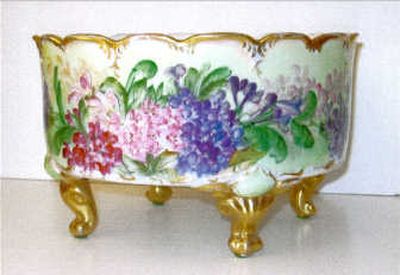THE COLLECTOR

Dear Collector,
My parents had this bowl that I have always loved. I wonder about its history and value. The marks on the bottom are “LE?, Vienna, Austria” and the initials “TK.”
The missing part of the puzzle is the name of an American Importer, P.H. Leonard, who counted Count Thun’s Porcelain Factory among his manufacturers. Thun, producing attractive ware, had potteries in several countries, including Austria. Your unsigned piece dates to around 1908. I’m not sure of its purpose; but I know it’s not a vegetable bowl, which usually has handles. Possibly decal decorated (it’s not marked “hand made”), which places a lower value on this type of porcelain; the potential value is $30-$50.
Dear Collector,
I was given this wooden box in the 1960s. The bottom reads “Flemish Art.” What is value and age?
Flemish Art of New York, whose company name became synonymous with pyrography wherein a pattern or design is burnt onto wood, produced this popular form of decorative art in the early 20th century. Some of the most fashionable motifs included floral and figural. Your circa 1910 lidded box is now worth $20-$30.
Dear Collector,
Enclosed are pictures of my salt and pepper shakers that I remember using during World War II. They originally contained mustard when my mother bought them. It says “G.C. Co.” on both.
I think the initials stand for Glass Containers Company, a manufacturer based in California. I did find a Derby Mustard that offered its product in jars that doubled as condiment bottles. Dating from the mid to late 1930s, your keepsake pair is listed at $20.
Dear Collector,
This photo is of a Jim Beam 1907 Thomas Flyer bottle. Can you tell me the value?
Your 1976 decanter commemorating this early automobile is too new for inclusion in this column. Remember, only antiques or vintage pre-1970 items will be commented on.
Dear Collector,
Family history records that this 1,000 Rupee note was brought home from India by my father’s father, who served with American forces during the war. We’ve kept it safe inside a book of stories by, appropriately, Rudyard Kipling. I know how important it is to my family, but does it also have a collectibility factor?
This 1937 issue was printed in Calcutta, one of the largest cities in the former Jewel in the Crown of the British Empire. By “collectibility factor,” you must mean value? While $150 may be the basis of a tiny nest egg (with today’s inflation, perhaps a hummingbird-sized egg), it doesn’t approach the historic importance of your family fortune.
Dear Collector,
Can you identify the maker of my ancient gravy boat? The only mark found is the letter “G” inside a five-pointed star.
I’m not exactly sure how old your silver piece is, but I discovered an A.T. Gunner of Attleboro, Mass., whom I’m certain, was the manufacturer. The earliest possible date that can be attributed to this item is the 1920s, which is when Mr. Gunner founded his company.